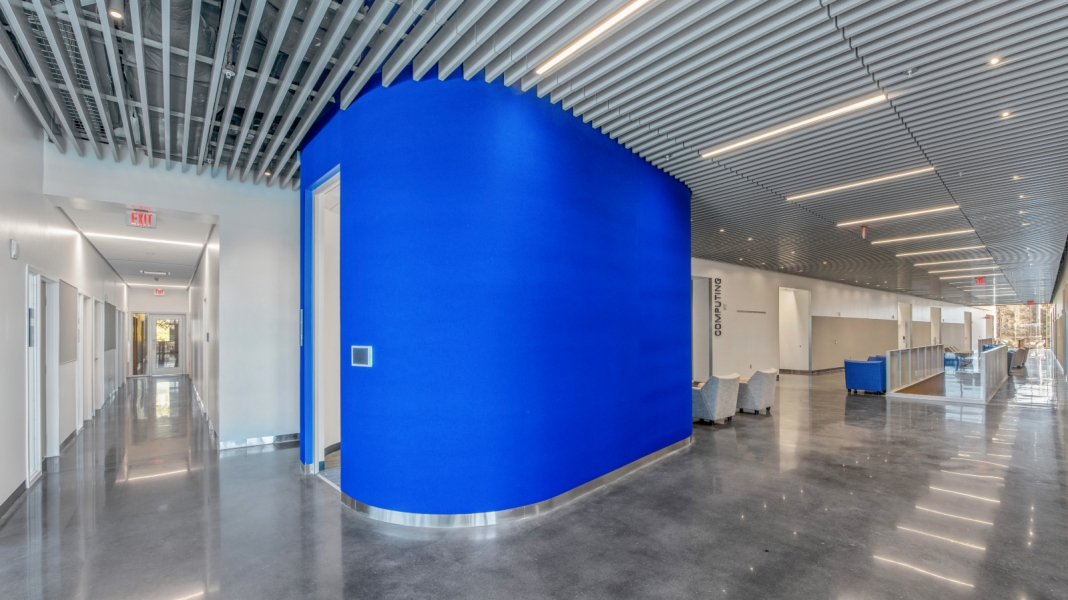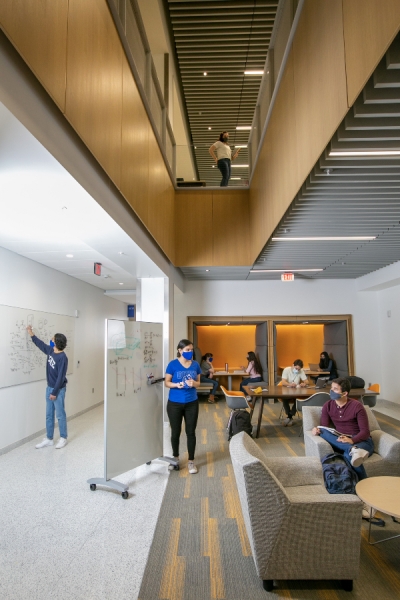Interview with the Architects: Behind the Design of Duke’s New Wilkinson Building
Bohlin Cywinski Jackson architects Natalie Gentile and Jason Morris discuss the vision and design decisions that gave shape to the Wilkinson Building

For nearly a decade, the Pittsburgh studio of architecture firm Bohlin Cywinski Jackson collaborated with Duke University leaders, faculty and staff to create a space that not only accommodates the Pratt School of Engineering’s rapid growth, but reflects its high aspirations for engineering education and research. Below, Bohlin Cywinski Jackson architects Natalie Gentile and Jason Morris discuss the vision and design decisions that gave shape to the Wilkinson Building—the newest landmark on Duke’s iconic campus.

What was the vision you were tasked with bringing to life on this project? How did you design the space to meet those goals?
Gentile: One of the key ambitions of this project was to focus, in a very intentional way, on the undergraduate engineering experience. This meant going beyond extending opportunities to support academic goals with new teaching and co-curricular spaces, to making a place for the students to call home. For example, the Learning Commons is one of several places for the students to meet, to study, and to create in formal and informal ways. And we really felt it was important to always be able to connect to the outside, see the daylight and take in a long view—this fosters a sense of wellbeing.
The weaving together of research and teaching was also a vision for the project that I truly appreciated. Dean Bellamkonda had a vision for research neighborhoods that bring departments within the school together. But because the research floors are layered over the dedicated floors for education, it was critical for us to provide opportunities for students and faculty to cross paths and to provide the invitation to explore the entire facility, to see and experience engineering in its most diverse reaches.
Morris: A big part of what makes the project unique compared to a lot of other academic facilities is the thoughtful creation of social and collaborative spaces that connect the teaching and research components of the facility. We focused on celebrating the vertical and horizontal movement through the building as a means providing visual connectivity across and through these spaces–for example, the cascading open stair that connects all levels of the building and invite students on the lower level up to the research neighborhoods. And the central collaboration spine, which has become known as “The Wedge,” provides a social heart and opportunities for the kind of serendipitous encounters that encourage cross-pollination of ideas.


What are the challenges of designing a new building for an iconic campus like Duke’s?
Morris: It is always a challenge to design a new modern building on a campus with such a rich architectural heritage as Duke’s. The compact site is one of the biggest challenges we faced at the outset of the project. But once we determined the best way to situate the building on the site, we started looking at some of the basic principles of the American campus Gothic tradition as a guide.
The most obvious example is the exterior’s emphasis on vertical elements and their spacing and rhythm, which informed the design of the curtain wall and sun-shading devices on the west and south facades. We also utilized proportional studies of some of the traditional building facades on campus as we designed the north and south elevations. That informed the scale and proportion of the windows and the manner in which the brick facing shifts in and out to visually break down the scale of these large elevations.

Tell us how you incorporated Duke stone into the project.
Morris: As one looks around the Duke campus, Duke stone is the most prevalent material one finds in the historic buildings. Duke has its own quarry nearby where the stone is sourced, and although it is is not as abundant in supply as it once was, there’s always a desire to make that relationship to the historic context with the materiality of a new building. Since we were limited in the amount of Duke stone we could use, we focused on some key areas–around the entrance of the building and into the interior, so you can see how the Wilkinson Building relates to the Chapel and historic quad nearby–and as the backdrop to the donor wall [where donors will be recognized]. We also used Duke stone extensively in the surrounding landscaping and retaining walls, which is the tradition around campus.


Over the course of the project you gathered input from many stakeholders across Duke and Pratt—including, very importantly, undergraduate and graduate students. Did the student focus groups provide any particular insights or ideas that are reflected in the final design?
Gentile: I truly enjoyed talking with the student focus groups. They’re so willing to give thoughtful feedback and I do remember two particular items that influenced decisions. One was requests for big tables, which you can now see throughout the building. The other was space for large groups to meet and collaborate, as well as designated quiet zones. I’m really happy to say that the building does provide a variety of spaces so that the students can find their favorite spots.

Sustainability is one of Duke’s core values, and a high priority for this particular project, which is aimed at achieving LEED Gold certification. How did you design the Wilkinson Building for long-term sustainability?
Gentile: Our approach was always to provide a lifetime building that can adapt over time to changing pedagogy and research topics. It was also important to design systems that are easy to operate and maintain. This speaks to both sustainability and resiliency, and I believe we have achieved that through the selection of durable, high quality materials–not just the ones that are seen throughout the building but those that are hidden in mechanical rooms and infrastructure shafts.
We also believe that buildings that are loved are well cared-for. This is a very sustainable strategy!
Now that the project is finally complete, how do you think it turned out? What are you most proud of, and what are your hopes for the Wilkinson Building as it comes into use?
Morris: I’ve been part of project for a few years now, and it’s always wonderful to start walking through the spaces as they’re being built and see our plans and drawings come to life. The spaces really start to come alive when you’re in them–understanding how the light reflects, how the spaces progress from one to the next as you move through them . . . you can’t really experience that until you walk through the building, and that to me is one of the most exciting things. The Wilkinson Building has really exceeded my expectations experientially. There are so many unique features that create experiences and opportunities for students to congregate and collaborate in meaningful ways.

Gentile: I think we got the internal dynamic quality right. We nailed the vertical and horizontal conductivity and the flow of the space. I think it’s a very easy building to navigate and to live in. But I am most proud of the truly collective effort that involved multiple stakeholder groups focused on a shared vision. I don’t think we would have had the success without the thoughtful contributions and timely decision-making.
Personally, I am most grateful for a happy client and the relationships that have developed from years of working together. I hope the occupants will find the Wilkinson Building a productive, energizing place to work and teach and to create–that they find inherent inspiration and new connections that foster the advancement of engineering.
